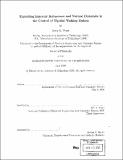| dc.contributor.advisor | Gill A. Pratt. | en_US |
| dc.contributor.author | Pratt, Jerry E | en_US |
| dc.contributor.other | Massachusetts Institute of Technology. Dept. of Electrical Engineering and Computer Science. | en_US |
| dc.date.accessioned | 2005-08-24T19:33:27Z | |
| dc.date.available | 2005-08-24T19:33:27Z | |
| dc.date.copyright | 2000 | en_US |
| dc.date.issued | 2000 | en_US |
| dc.identifier.uri | http://hdl.handle.net/1721.1/9084 | |
| dc.description | Thesis (Ph.D.)--Massachusetts Institute of Technology, Dept. of Electrical Engineering and Computer Science, 2000. | en_US |
| dc.description | Includes bibliographical references (p. 115-120). | en_US |
| dc.description.abstract | Walking is an easy task for most humans and animals. Two characteristics which make it easy are the inherent robustness (tolerance to variation) of the walking problem and the natural dynamics of the walking mechanism. In this thesis we show how understanding and exploiting these two characteristics can aid in the control of bipedal robots. Inherent robustness allows for the use of simple, low impedance controllers. Natural dynamics reduces the requirements of the controller. We present a series of simple physical models of bipedal walking. The insight gained from these models is used in the development of three planar (motion only in the sagittal plane) control algorithms. The first uses simple strategies to control the robot to walk. The second exploits the natural dynamics of a kneecap, compliant ankle, and passive swing-leg. The third achieves fast swing of the swing-leg in order to enable the robot to walk quickly (1.25m). These algorithms are implemented on Spring Flamingo, a planar bipedal walking robot, which was designed and built for this thesis. Using these algorithms, the robot can stand and balance, start and stop walking, walk at a range of speeds, and traverse slopes and rolling terrain. Three-dimensional walking on flat ground is implemented and tested in simulation. The dynamics of the sagittal plane are sufficiently decoupled from the dynamics of the frontal and transverse planes such that control.-of each can be treated separately. We achieve three-dimensional walking by adding lateral balance to the planar algorithms. Tests of this approach on a real three-dimensional robot will lead to a more complete understanding of the control of bipedal walking in robots and humans. | en_US |
| dc.description.statementofresponsibility | by Jerry E. Pratt. | en_US |
| dc.format.extent | 157 p. | en_US |
| dc.format.extent | 29248663 bytes | |
| dc.format.extent | 29248423 bytes | |
| dc.format.mimetype | application/pdf | |
| dc.format.mimetype | application/pdf | |
| dc.language.iso | eng | en_US |
| dc.publisher | Massachusetts Institute of Technology | en_US |
| dc.rights | M.I.T. theses are protected by copyright. They may be viewed from this source for any purpose, but reproduction or distribution in any format is prohibited without written permission. See provided URL for inquiries about permission. | en_US |
| dc.rights.uri | http://dspace.mit.edu/handle/1721.1/7582 | |
| dc.subject | Electrical Engineering and Computer Science. | en_US |
| dc.title | Exploiting inherent robustness and natural dynamics in the control of bipedal walking robots | en_US |
| dc.type | Thesis | en_US |
| dc.description.degree | Ph.D. | en_US |
| dc.contributor.department | Massachusetts Institute of Technology. Department of Electrical Engineering and Computer Science | |
| dc.identifier.oclc | 46874863 | en_US |
